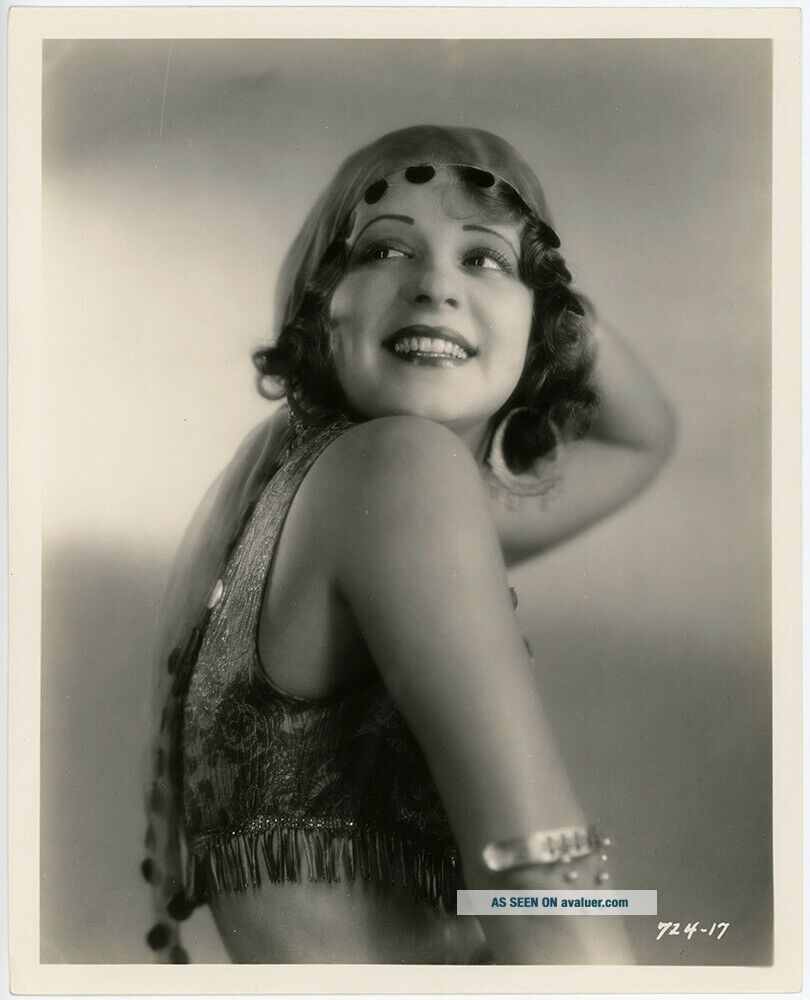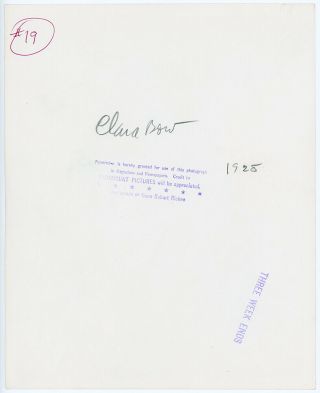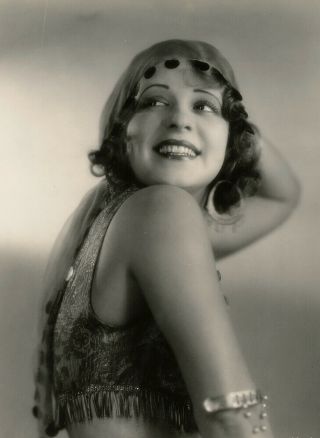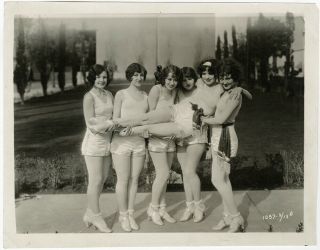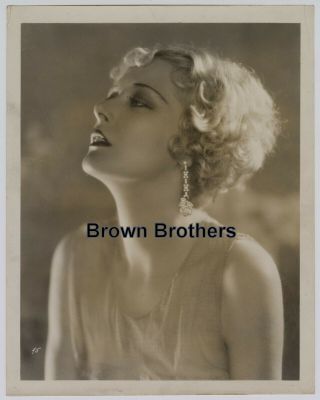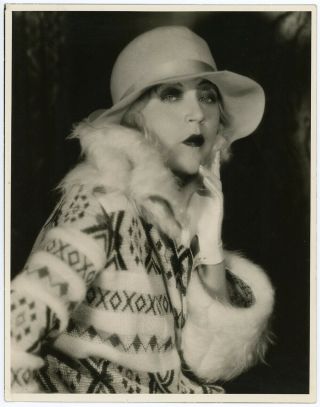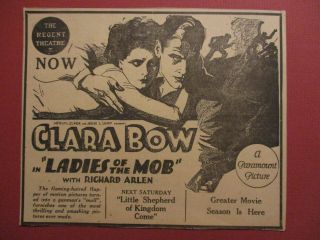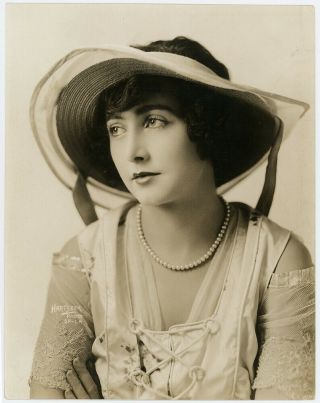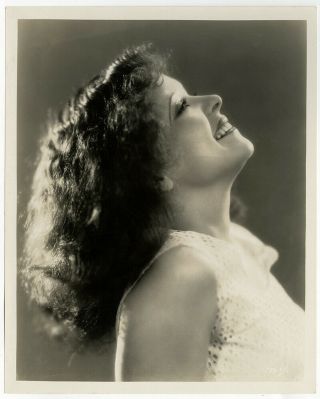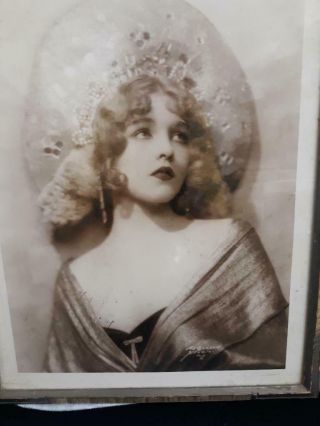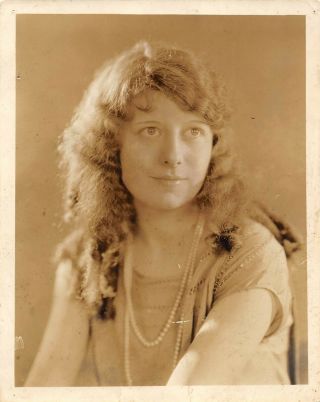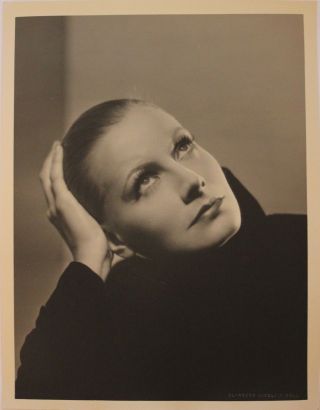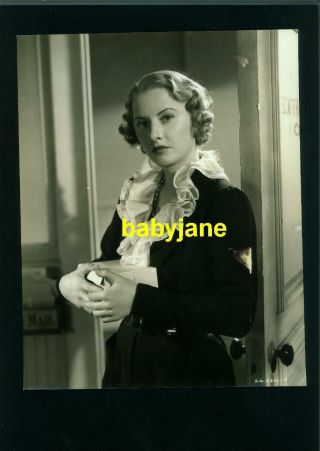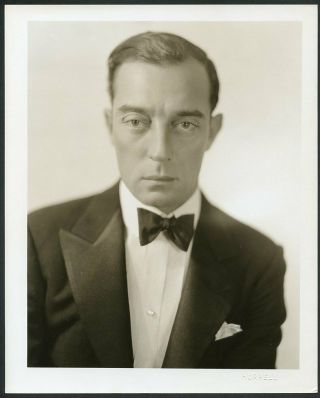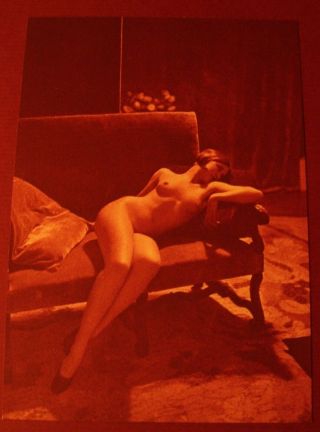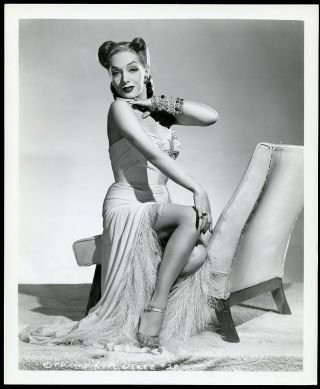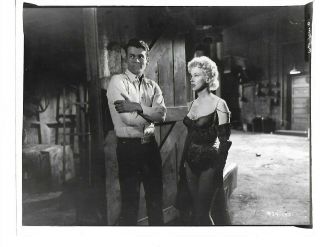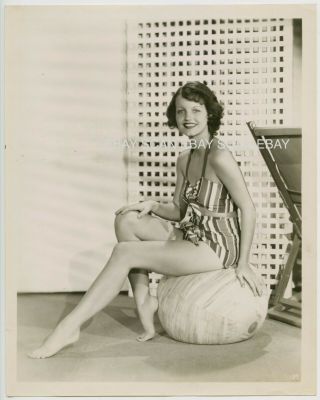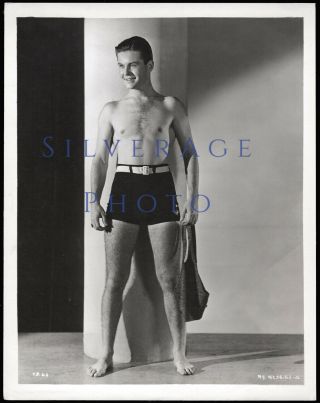Vintage 1928 Bohemian Silent Film Beauty Clara Bow Three Week Ends Photograph
Item History & Price
Thanks to all our eBay bidders! We are honored to be your one-stop, 5-star source for vintage pin up, pulp magazines, original illustration art, decorative collectibles and ephemera with a wide and always changing assortment of antique and vintage items from the Victorian, Art Nouveau, Art Deco, and Mid-Century Modern eras. All items are 100% guaranteed to be original, vintage, and as described. Please feel free to contact us with any and all questions about the items and our p...olicies and please take a moment to peruse our other great eBay listings. All sell no reserve!
ITEM: This is a vintage and original Paramount Pictures production still photograph taken by Eugene Robert Richee of Hollywood's original "It" girl Clara Bow. This beautiful Bohemian-inspired portrait was taken in promotion of Bow's 1928 silent film Three Week Ends.
Rising to stardom in silent film during the 1920s and successfully making the transition to "talkies" after 1927, Bow's appearance as a plucky shopgirl in the film "It" brought her global fame and the nickname "The It Girl". Bow came to personify the Roaring Twenties and is described as its leading sex symbol. Bow appeared in 46 silent films and 11 talkies and was named first box-office draw in 1928 and 1929 and second box-office draw in 1927 and 1930. Her presence in a motion picture was said to have ensured investors, by odds of almost two-to-one, a "safe return". At the apex of her stardom, she received more than 45, 000 fan letters in a single month (January 1929). Two years after marrying actor Rex Bell in 1931, Bow retired from acting and became a rancher in Nevada. Her final film, Hoop-La, was released in 1933. In September 1965, Bow died of a heart attack at the age of 60.
Measures 8" x 10" on a glossy single weight paper stock.
Ink stamps and handwritten notations on verso.
CONDITION: Fine condition with light, general storage/handling wear. Please use the included images as a conditional guide.
Guaranteed to be 100% vintage and original from Grapefruit Moon Gallery.
••••••••••••••••••••
Clara Bow was born in a run-down tenement in old Brooklyn, to a schizophrenic Mother and a chronically destitute, physically abusive father. As a child, she was a tomboy and played games in the streets with the boys; since her clothes were so ragged and dirty other girl children wouldn't play with her. Her best friend Johnny burned to death in her arms when she was 10 years old. Years later, she could make herself cry at will on a movie set by listening to the lullaby "Rock-A-Bye Baby". She claimed it reminded her of her small friend. She also told reporters simple, brutal, honest stories about her horrific childhood, which was a big no-no in her day. Mental illness in the family was considered more shameful than unmarried pregnancy. This made Clara a lot of enemies in Hollywood.
She entered "The Fame and Fortune Contest" as a teenager. Girls from all over the country competed, and the 1st Prize was a part in a movie. She showed up in her ragged clothes and the other girls smirked at her. The contest judges paid no attention to her until she did her screen test - and then they unanimously chose her over all the other girls. Clara lit up the screen like nothing they had ever seen. She got the part, but it was later cut from the movie. During this time her mother tried to kill her and was institutionalized, where she died shortly after.
She was taken to Hollywood by B.P. Schulberg, who used Clara sexually and financially. He worked her like a horse and paid her very little compared to other stars of the day. Even so, the talented Clara became a superstar, and the first ever Hollywood sex symbol. Clara could flirt with the camera just by looking into it with her big brown eyes and mischievous bow-tie grin. She exuded sex appeal from every pore in her little body and was not afraid to flaunt it. She personified "flaming youth in rebellion". Her characters were always working class gals; manicurists, showgirls and the like. Her movies did a lot to emancipate young Americans from the restrictive Victorian morals their parents had been raised with. Clara's characters were unashamed about being attracted to men and went after them with gusto. Her shop girl in It (1927) sees the bosses son one day, and says "Oh Santa, gimme him!" She knows exactly what to do to get him interested and then keeps him on his toes. Her characters cut their dresses up to look sexier, cut off their hair, drank and smoked in public, and danced all night long. At the height of her career, she received 45, 000 fan letters a week, a record that has never been equaled. She was the idol of working girls and the dream of working class guys everywhere.
Even though the public adored Clara, Hollywood shunned her. Most of Hollywood's big names of the 1920s had come from poor backgrounds like Clara, but when they made it big they tended to develop upper class values and personas. They pretended their poor childhoods had never happened. Clara didn't. Clara never hid anything; that was her problem. It was later discovered by a biographer that Clara was actually schizophrenic, like her mother. One of the hallmark signs of schizophrenia is a total unconcern with social mores. Clara loved to tell really dirty jokes at parties when the conversation lulled, or make blatant remarks about the size of her (many) lovers to other, more prudish girls. She had very public affairs (her euphemism was "engagements") with a score of leading men and directors, including Victor Fleming, Gary Cooper, and Gilbert Roland. This behavior horrified her peers, and eventually she was driven out of Hollywood. Many nasty rumors about her sexuality floated around the movie colony, including the one about her taking on the entire USC Football Team one night, which was finally disproved by a biographer, David Stenn.
The coming of sound was like an earthquake to Hollywood. It shook up everything. Her fans probably wouldn't have minded her blue collar Brooklyn accent, since most of them were working class gals themselves, but Clara got herself so worked up with mike fright she had breakdowns during her first talkies. Before she could recover from this, she ended up in court with her private life splashed all over the papers, which didn't help matters one bit. Her secretary and best friend, Daisy De Voe, was caught embezzling from her. When Clara took Daisy to court, Daisy told the court and press uncensored details of Clara's sex life, along with lots of exaggeration, which the press automatically printed and believed. The scandal ruined Clara. She had another more serious breakdown and had to recover in a sanatorium. Soon after she retired for good, and moved to Nevada with her new husband, the cowboy actor Rex Bell. She raised two sons, all the while battling her mental illness, and died in obscurity in 1965.
- IMDb Mini Biography By: redmaeve
••••••••••••••••••••
Eugene (sometimes also just called Gene) Robert Richee was born August 21, 1896 in Denver, Colorado. Richee began his career in the silent movie era. He got his job at Paramount in the late teens through his friend Clarence Sinclair Bull. He started shooting stars while Donald Biddle Keyes was taking portraits in the gallery. When Keyes left Paramount, Richee took over, and for two decades he photographed the studio's stars including Gloria Swanson, Rudolph Valentino, Claudette Colbert, Fredrick March, the Marx Brothers and Carole Lombard. Lombard so admired his work with Dietrich that she started posing in some of the same ways to get that 'glamour mysterious' look.
Richee was the perfect technician for Joseph Von Sternberg, who controlled Dietrich's career. All sittings were supervised by von Sternberg for the lighting setups, and directed the action just as he did on the studio floor. When Dietrich's collaboration with Von Sternberg ended, Richee continued to take her portraits, which retained the look of the von Sternberg originals. It could be said that Richee learned plenty from the great director that he used for many of his own stills.
He took portrait photographs of stars on the sets of some of Paramount Pictures most well known classics. As his talent became more and more prevalent, he was put in charge of the main portrait gallery at Paramount. He worked with a talented coterie of associates including William Walling and Don English. Richee remains the least examined among the top Hollywood photographers although he was one of the finest--one needs to look no further than his sensational portraits of Paramount stars like Anna Mae Wong, Clara Bow, and Marlene Dietrich among others.
From 1925 to 1935 took many photographs of Louise Brooks. Perhaps Richee's most famous work is a 1928 portrait of Louise Brooks wearing a long string of pearls. Few photos capture better the zeitgeist of the Roaring '20s. Simplicity is the hallmark of this photograph, along with masterful composition. Brooks stands, face in profile and wearing a long-sleeved black dress, against a black background, her face hands and pearls along illuminated. Her bob, with its razor-sharp line across the white skin of her jaw, was widely copied and became one of the last century's most potent fashion statements. Brook's career had intermittent highs and lows, but she was one of Hollywood's great portrait subjects and was never better served than by Richee.
Even a tireless researcher like Kobal had difficulty uncovering biographical information about Richee, and it is only after Kobal's death that a few details have emerged about Richee's life including his 1896 birth in Colorado. He started at Paramount in 1921 and stayed there twenty years, after which he took a job at Warner Brothers. Richee died in 1972, just before Kobal began exploring seriously the careers of Hollywood portrait photographers. Like Ruth Harriet Louise, Richee left scant biographical information behind but, again like Louise, he left a corpus of extraordinary work that may be seen as emblematic of the best of Hollywood photography.
Richee was an inventive photographer and when working with starlets he sometime incorporated props made of plastic, glass or even mirrors, giving his prints a sparkling reflective quality. Portraits of the top stars always had a sheen that was consistent with the studio's image of smart sophistication. When he photographed Clara Bow, the studio's number one sexpot took on a polished veneer. Richee has the distinction of being the first photographer to record Veronica Lake and her distinctive blonde locks in his portraits for 'I Wanted Wings' (1940), the film that brought her worldwide fame.
Gary Cooper had made more than thirty films over five years when he was cast in 1930 as Dietrich's first Paramount co-star in 'Morocco' (1930). He was the first male Hollywood star to bridge the opposing forces of masculinity and beauty. Plenty of handsome men had great careers before Cooper, but none so perfectly fused with what had always been considered opposites. Richee photographed him extensively, beginning when he was a touch too beautiful for a young man, and followed his transformation to the exemplar of male virility. According to Bob Coburn, who worked principally at Columbia, Cooper was 'embarrassed a little bit at constantly being photographed. He preferred to be in movement in front of the camera.’
At the top of his game and for unknown reasons, Richee left Paramount in 1941 to go to Warner Brothers. A. L. 'Whitey' Schafer, who had been in the top position at Columbia, replaced Richee. This change indicated that Paramount's image was shifting away from the opulent glamour that had typified publicity material released during the two previous decades.
Richee later worked for MGM and Warner Brothers. In his role, Richee became the premiere photographer of stars such as Dorothy Lamour, Jean Arthur, Mae West, Gary Cooper, and Fay Wray, William Powell, Irene Dunne, Veronica Lake, Fredrick March, Nancy Carroll, Gloria Swanson, and Carole Lombard.
Some stars became so accustomed to Richee they wanted only to work with him. Miriam Hopkins was one of them. It was said she was quite curt and frigidity when Richee was working elsewhere and she had to be photographed instead by William Walling. Walling says: "She was being difficult from the moment she arrived, because Richee was not there.”
Oddly enough, Dietrich herself was much more pleasant when she found out that Richee was on vacation and she would have to be photographed by Walling. Of course, Von Sternberg was with her.
Virgil Apger, Richee's assistant (and brother-in-law) developed Richee's negatives, worked on with the dryers, and made prints. He recalled: "Gene never left a sitting with fewer than a hundred negatives, which had to be retouched and printed." Retouching was the norm by then for all photographers in Hollywood.
Richee passed away on April 21, 1972 in Orange County, California. He was survived by his wife, Levaughn Larson.
— Biography From: VintageMovieStarPhotos (dot) blogspot (dot) com
••••••••••••••••••••



